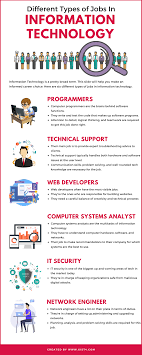
Exploring the Various Types of Information Technology
The Various Types of Information Technology
Information technology (IT) encompasses a wide range of technologies that are used to create, store, exchange, and use information in various forms. Here are some common types of information technology:
- Hardware: This includes physical devices such as computers, servers, routers, and storage devices that are used to process and store data.
- Software: Software refers to programs and applications that run on hardware devices to perform specific tasks. This includes operating systems, productivity software, and specialized applications like graphic design programs.
- Networking: Networking technologies enable the communication and sharing of information between devices. This includes protocols, network infrastructure components like routers and switches, and wireless technologies.
- Internet and Web Technologies: These technologies facilitate the transfer of information over the internet. This includes web development tools, web browsers, e-commerce platforms, and content management systems.
- Data Management: Data management technologies encompass databases, data warehouses, data mining tools, and other solutions for storing and analyzing large volumes of data.
- Cybersecurity: Cybersecurity technologies protect digital assets from unauthorized access or attacks. This includes firewalls, encryption tools, intrusion detection systems, and antivirus software.
- Cloud Computing: Cloud computing technologies enable the delivery of computing services over the internet. This includes cloud storage solutions, software as a service (SaaS) applications, and cloud infrastructure platforms.
These are just a few examples of the diverse types of information technology that play crucial roles in our modern digital world. As technology continues to evolve rapidly, staying informed about these different types of IT is essential for individuals and organizations alike.
7 Essential IT Tips to Enhance Security and Stay Updated
- Stay updated on the latest technology trends.
- Regularly backup your data to prevent loss.
- Use strong and unique passwords for security.
- Be cautious of phishing scams and suspicious emails.
- Keep your software and applications up to date.
- Enable two-factor authentication for added security.
- Secure your wireless network to prevent unauthorized access.
Stay updated on the latest technology trends.
To stay ahead in the ever-evolving landscape of information technology, it is crucial to stay updated on the latest technology trends. By keeping abreast of emerging technologies and industry developments, individuals and organizations can adapt their strategies, enhance their skills, and leverage new opportunities. Remaining current with technology trends not only allows for better decision-making but also fosters innovation and competitiveness in a rapidly changing digital world.
Regularly backup your data to prevent loss.
Regularly backing up your data is a crucial practice in safeguarding your information and preventing loss. By creating duplicate copies of your files and storing them in secure locations, you can mitigate the risk of data loss due to hardware failure, cyberattacks, or accidental deletion. Implementing a consistent backup routine ensures that you can easily restore your data in the event of an unforeseen incident, providing peace of mind and protection for your valuable information. Remember, it’s better to be proactive about data backup than to deal with the consequences of losing important files.
Use strong and unique passwords for security.
Using strong and unique passwords is a fundamental practice in ensuring the security of your information technology systems. A strong password should be complex, incorporating a mix of letters, numbers, and special characters to enhance its resilience against hacking attempts. Furthermore, using unique passwords for each account or system adds an extra layer of protection, as it prevents a security breach in one platform from compromising all your other accounts. By prioritizing the creation of strong and unique passwords, individuals and organizations can significantly reduce the risk of unauthorized access and safeguard their sensitive data from potential cyber threats.
Be cautious of phishing scams and suspicious emails.
It is crucial to exercise caution when navigating the digital landscape, especially concerning phishing scams and suspicious emails. Phishing scams are deceptive attempts to acquire sensitive information, such as usernames, passwords, and financial details, by posing as trustworthy entities. These fraudulent emails often contain links or attachments that can compromise your personal data or infect your devices with malware. By remaining vigilant and scrutinizing emails for authenticity before clicking on any links or providing information, you can help protect yourself from falling victim to these malicious schemes. Remember, staying informed and practicing good cybersecurity habits are essential in safeguarding your online presence.
Keep your software and applications up to date.
It is essential to keep your software and applications up to date to ensure optimal performance and security. Regular updates often include bug fixes, enhancements, and patches that address vulnerabilities that could be exploited by cyber attackers. By staying current with software updates, you not only benefit from improved functionality but also reduce the risk of potential security breaches and data loss. Make it a habit to regularly check for updates and install them promptly to maintain the efficiency and integrity of your digital systems.
Enable two-factor authentication for added security.
Enabling two-factor authentication is a highly recommended security measure when utilizing various types of information technology. This additional layer of security significantly enhances the protection of your accounts and sensitive data by requiring a secondary verification step beyond just a password. By implementing two-factor authentication, users can safeguard their online accounts from unauthorized access, as it typically involves a unique code sent to a separate device or generated through an app. This simple yet effective security practice adds an extra barrier against potential cyber threats and ensures that only authorized individuals can access your digital information.
Secure your wireless network to prevent unauthorized access.
To safeguard your digital information and prevent unauthorized access, it is crucial to secure your wireless network. Implementing strong security measures such as using encryption protocols, setting up strong passwords, and enabling firewalls can help protect your network from potential cyber threats. By securing your wireless network, you can ensure that only authorized users have access to your data and devices, enhancing the overall security of your digital infrastructure.

